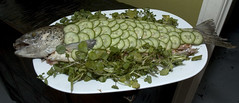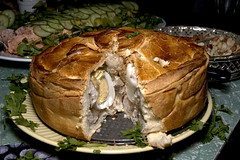A large salmon with several complications
Vince Garreffa tells us that you should cook every dish twice; once for yourself and then for your guests. Such careful hospitality is lost on me. I'm a 'sharing the journey' host.
Plan
One large salmon. Instead of merely poaching it, I'd make a court bouillon, freeze the court boullion, place the frozen boullion in a vacuum sealer bag with the whole salmon, vacuum seal the bag and then cook it sous vide. Remove gently cooked salmon from bag, remove skin and cover with cucumbers to resemble scales.
The logic was impeccable. The salmon would be gently poached in water but trapped in a sealed bag with a smaller volume of flavoursome stock. The genius part was freezing the court bouillon so it didn't end up being sucked into the pump of the vacuum sealer. It also meant it could be done well ahead of time without the fish marinating.

Reality
In retrospect, when the salmon was sealed in a bag with what looked like a pink urinal cake, it should have been a sign of trouble to come but it all came with sound reasons. The carrots, red onions and the white wine turned the court boullion into a pinkish shade. It was just unfortunate that I chose a flat bottomed pudding bowl to freeze it in.
Moving on. Three kilogram salmon are long. Long than any pot or dish you'll own and longer than any commercially available disposable roasting tray. I used the disposable roasting tray and it looked like a tall man who'd mistakenly booked in for a night at a hobbit bed and breakfast. The weight of the salmon slowly pushed down the sides and simmering water would leak out onto the burners until they filled with water and made a sad gurgling sound.
At this point I realised I had to either change tack or accept the fact that guests would have to suffer food poisoning. It was a tough call but I eventualy wrapped the half poached salmon in foil and tried to fit it in the oven to finish it off. It fitted at an angle, once I snapped the tail off and was eventually cooked at a gentle temperature.
Redemption
The good bit was that I sliced a whole burpless cucumber on a mandoline without losing any bits of fingers. Skin taken off the salmon and the grey bits gently scraped off and the cucumber 'scales' added - they hid the 'join' on the tail.
It was also damned tasty.

Notes: the court bouillon I used comes from here and adjusted - half a bottle of Semillon Sauvignon Blanc, a cup of water, a handful of parsley, a twigs of thyme, half a dozen peppercorns, 2 bay leaves, a chopped red onion, one sliced carrot, one sliced stick of celery with leaves, juice of half a lemon and a tsp of salt.
Simmered for half an hour and then strained.













